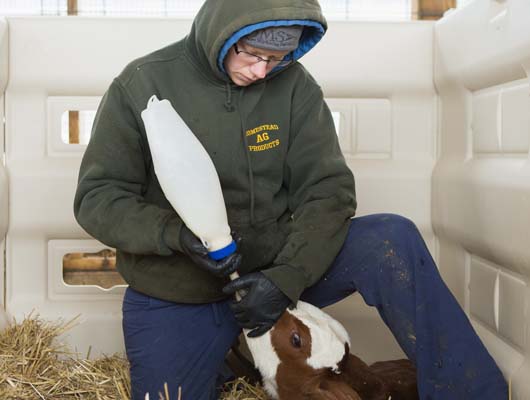by Cari Reynolds, W.H. Miner Institute
Colostrum management on farms is used to prevent the spread of disease, provide optimal nutrition to stimulate growth, and maximize passive transfer of immunity to newborn calves; this is no doubt a focus for every producer. Numerous publications and guidance exist reiterating the significance of clean, high-quality colostrum for calf health, growth, and sufficient transfer of antibodies, as well as best practices on-farm to maintain colostrum quality. This ‘liquid gold’ is influenced by more factors than one can count, including dam’s age, calving season, and even the length of dry period. While there are some factors outside of our control, how we manage colostrum prior to feeding is not, especially with regard to cleanliness. But, could we be potentially eliminating more than just harmful bacteria?
Contamination of colostrum with bacteria not only elevates the calf’s illness risk, but also considerably interferes with passive transfer of immunoglobulin G (IgG), one of the most important factors in immune development and calf survival. In addition to sanitized equipment and proper protocols for colostrum collection, many farms employ heat treatment (lower temperature, longer time) to reduce bacterial count. Several Journal of Dairy Science studies have investigated the effects of temperature and duration of heat treatment on colostrum, and have found that heating above the recommended 60°C (140°F) for 60 min can have a detrimental effect on IgG concentrations.
However, there are still concerns that heat treatments might influence colostrum quality across varying quality levels. Research from The Pennsylvania State University aimed to evaluate the effect of heat treatment times (no treatment, 30, or 60 min) on three different levels of colostrum quality (low, medium, and high) and its effect on passive transfer rates. The authors hypothesized that high quality colostrum would be more affected by heat treatment than lower quality colostrum.

First milking colostrum was pooled by quality according to colostrometer results, and then divided into 3 unique batches. The initial IgG concentrations used to dictate low, medium and high colostrum quality levels were 52.3, 65.7, and 98.1 mg/mL, respectively. Three uniform batches of each quality level were then created. Of these batches, one was frozen untreated at -20°C (-4°F), while 2 were heated to 60°C for either 30 or 60 min, cooled, and immediately frozen at -20°C. Samples from each batch were taken prior to treatment to determine bacterial content and initial IgG concentration. Calves (54 heifers and 54 bulls) were randomized to receive 1 of 9 colostrum batches, stratified by heat treatment (0, 30 and 60 min) and quality (low, medium, high), within 2 h of birth. Blood was collected from each calf prior to colostrum feeding and then 24 h after birth for serum IgG measurement and determination of successful passive transfer.
Results from this study found that colostrum IgG levels in the unheated batches were greater than in those that were heated. When compared to the unheated batches, those heated for 30 and 60 min demonstrated IgG concentration reductions of 9 and 12%, respectively. However, calves fed colostrum heated for either 30 or 60 minutes showed a 3.4 and 27.2% increase in serum IgG concentration over those fed unheated colostrum. Absorption was also improved in those calves fed colostrum heated for 60 min in comparison to 30 min. Ultimately, there was no significant change in IgG concentration with either 30 or 60 minutes of heating time, irrespective of initial colostrum quality.
Regardless of heat treatment’s impact on IgG concentrations in colostrum, there is still considerable benefit to the calf in terms of available IgG antibodies and lower bacterial counts in batches subjected to heat treatment than those that are not. The colostrum used in this study had comparably low bacterial count, so absorption rates may have been attributable to initially higher antibody availability from less bacterial interference, and less so to heat treatment. Other considerations may need to be made for colostrum with variable bacterial presence. Multiple other studies have also highlighted the improvement of passive transfer through heat treatment of colostrum. Difference in duration of heat treatment seemed to have no effect on IgG concentration, but likely still improved absorption and passive transfer rates by lowering the bacterial content of these batches. While this study was unable to positively determine the effect of heating time on colostrum quality, inferences for good colostrum management are still supported by the results. Colostrum quality should still continue to be measured when possible to ensure that IgG levels and bacterial count are within industry-recommended standards, and cleanliness should always be at the forefront from teat to tummy. So keep warming up that bottle for baby!
Cari Reynolds earned a BS in Biology from the University of Scranton and a Master of Public Health from the University of Massachusetts – Amherst. After several years working in the public health sector, Cari returned to her agricultural interests and she is currently a research intern at W.H. Miner Institute. In the fall, Cari will begin a Ph.D. program in Animal Science at the University of Vermont, where her research will focus on management and preventative strategies to mitigate diseases that impact both human and animal health. She can be reached at reynolds@whminer.com.
REFERENCES:
https://www.journalofdairyscience.org/article/S0022-0302(19)30064-5/pdf
https://www.sciencedirect.com/science/article/pii/S0749072007000758?via%3Dihub
Courtesy of our dealer – CRI REPRODUCCIÓN ANIMAL MÉXICO SA DE CV.
